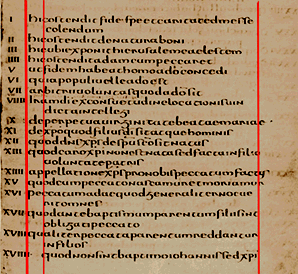The list of chapter headings is left-justified and roughly
right-justified.

Each chapter-heading
which is longer than one line is given a hanging indent.
The numbers of the chapters are also left-justified, in a
separate column nearer to the edge of the page.
 |
at the end of chapter 14, the scribe has
conjoined the u and
s of the ending in order to right-justify the page. |
Oops!
The scribe has made a classic mistake: he has missed out one of the chapter headings.
Someone, possibly he himself, has then corrected the mistake by writing in the missing title
and number in the gap between lines after Chapter 7. Since there is no room to write it
in the original script, he has used Cursive Half-Uncial, the usual script used for annotating
classical texts.

He has then made an attempt to straighten out the numbering. Since he uses Roman numerals,
he can add an extra I to many of the numbers.
 |
This was originally VIII, 8. He has
added an I to make it 9. This is an acceptable way of expressing 9 in later
medieval accounts: 4 was usually written iiii. |
 |
This does not work when he gets to IX, 9,
which should really be X, 10. (This suggests that he may not have used
VIIII normally.) He has to scrape out the I.
Scraping with a penknife or pumice stone was the usual method of erasing mistakes made on parchment. |
 |
With XV he seems to have got back
into the swing again: there is no sign in this facsimile of any scraping out of an
I between X and V. |
By the time he gets on to XVIIII the number is too long for the layout,
and he has to line up the chapter-heading with the hanging indent.

Go back to Question Page.
Go back to Index.
© MEG TWYCROSS 1999











